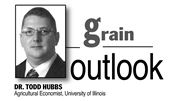2018-19 Market Outlook For Corn And Soybeans

The USDA released the first projections for U.S. corn and soybean supply and demand in the 2018-19 marketing year on May 10. Forecasts for both crops indicate lower ending stocks next marketing year with a substantial decrease in corn ending stocks. The upcoming growing season's impact on production is a crucial determinant to a possibility of lower ending stocks next year. However, the projections for marketing year consumption levels provide essential information in forming expectations for corn and soybean prices. The consumption projections for both crops reflect the potential market size under a scenario consisting of lower supplies and higher prices.
2018-19 production projections came in lower than last year for both crops. The U.S average corn yield is projected at 174 bushels per acre with production at 14.04 billion bushels. The U.S. average soybean yield is projected at 48.5 bushels per acre with production at 4.28 billion bushels. Yield potential for both crops will unfold over the next few months and will be determined by weather conditions. Additionally, planted acreage levels are yet to be determined and still have a significant amount of uncertainty due to delayed planting in large areas of the northern Corn Belt. The USDA's June Acreage report will provide more clarity on June 29.
Soybean demand projections moved higher next marketing year despite numerous trade issues currently impacting the market. Soybean consumption sees a projected boost from domestic crush expansion. At 1.995 billion bushels, the projected crush level is 5 million bushels above estimates for the current marketing year. This projection reflects an expectation of global soybean meal increasing by five percent as livestock production continues to expand around the world. Soybean oil exports look to expand three percent globally with stiff competition from various vegetable oils. Domestically, soybean meal consumption is projected to increase while exports move lower as Argentina recovers from recent production setbacks.
The soybean export projection for 2018-19 sits at 2.29 billion bushels, 225 million bushels above the current marketing year. The expansion of soybean exports in the presence of a large Brazilian crop and Chinese officials indicating a 0.3 percent decline in imports reflects an expectation of a 5 percent increase in global soybean imports. Growth in world demand for soybeans is dependent on continued demand growth in Asian markets. Recent reports out of China provide an expectation of expansion in domestic soybean production by five percent. Additionally, a reduction of crush levels due to low hog prices and expanded DDGS production associated with increased ethanol production in China bear monitoring over the next year. While Chinese trade and domestic use targets may not come to fruition, the optimistic outlook for soybean exports is dependent on the Chinese market and key to lower ending stocks next marketing year. Total consumption, including seed and residual use, is projected at 4.420 billion bushels, 232 million bushels above use during the current year. Projections reflect expectations of continued demand growth both domestically and in foreign markets.
In the corn market, corn use for ethanol is forecast at 5.625 billion bushels, 50 million bushels above the revised projection for the current year. The corn use for ethanol projection reflects the high levels of domestic ethanol production thus far in the 2017-18 marketing year. The importance of ethanol exports and continued growth in gasoline demand are key variables in meeting this projection. A flat to slightly higher corn use for ethanol forecast in 2018-19 appears likely under current ethanol export levels and gasoline prices.
Corn exports projections came in at 2.1 billion bushels, 125 million bushels lower than the 2.225 billion bushels expected for the current marketing year. The corn production issues in South America look to boost demand growth in export markets for U.S. corn. Brazilian corn production this year is revised down almost 450 million bushels from last year. When combined with the poor Argentinian crop, corn exports this marketing year look to be approximately 102 million bushels lower than last marketing year out of the region. While production in South America is projected to recover in 2018-19, U.S. exports should benefit over the remainder of 2018.
Feed and residual use of corn is projected at 5.375 billion bushels, 125 million bushels lower than the 5.5 billion bushels expected for the current marketing year. The projection reflects the expectation of a smaller crop and the impact of distiller's grains in feed rations. Consumption for all uses is projected at 14.59 billion bushels, 175 million bushels less than the current marketing year.
Ending stocks of U.S. corn for the 2018-19 marketing year are projected at 1.682 billion bushels, down 500 million bushels from current marketing year ending stock projections. The reduction in ending stocks is directly related to the expectation of significantly lower production. Ending stocks of U.S. soybeans are projected at 415 million bushels, 115 million bushels lower than the current marketing year ending stock projections. Reduced soybean ending stocks reflect the optimism in soybean demand and lower production.
The projection for the 2018-19 average farm price of corn is in a range of $3.30 to $4.30. Current bids for harvest delivery in much of Illinois are slightly above the middle of that range. Any potential weather issues combined with continued strength in corn demand set up a scenario for a positive price response as we move into the summer. The average price for soybeans is projected in a range of $8.75 to $11.25, with harvest bids in much of Illinois currently below $10. The ability for U.S. soybeans to expand exports next year will be essential in meeting the projected increase in soybean consumption. ∆
DR. TODD HUBBS: Agricultural Economist, University of Illinois